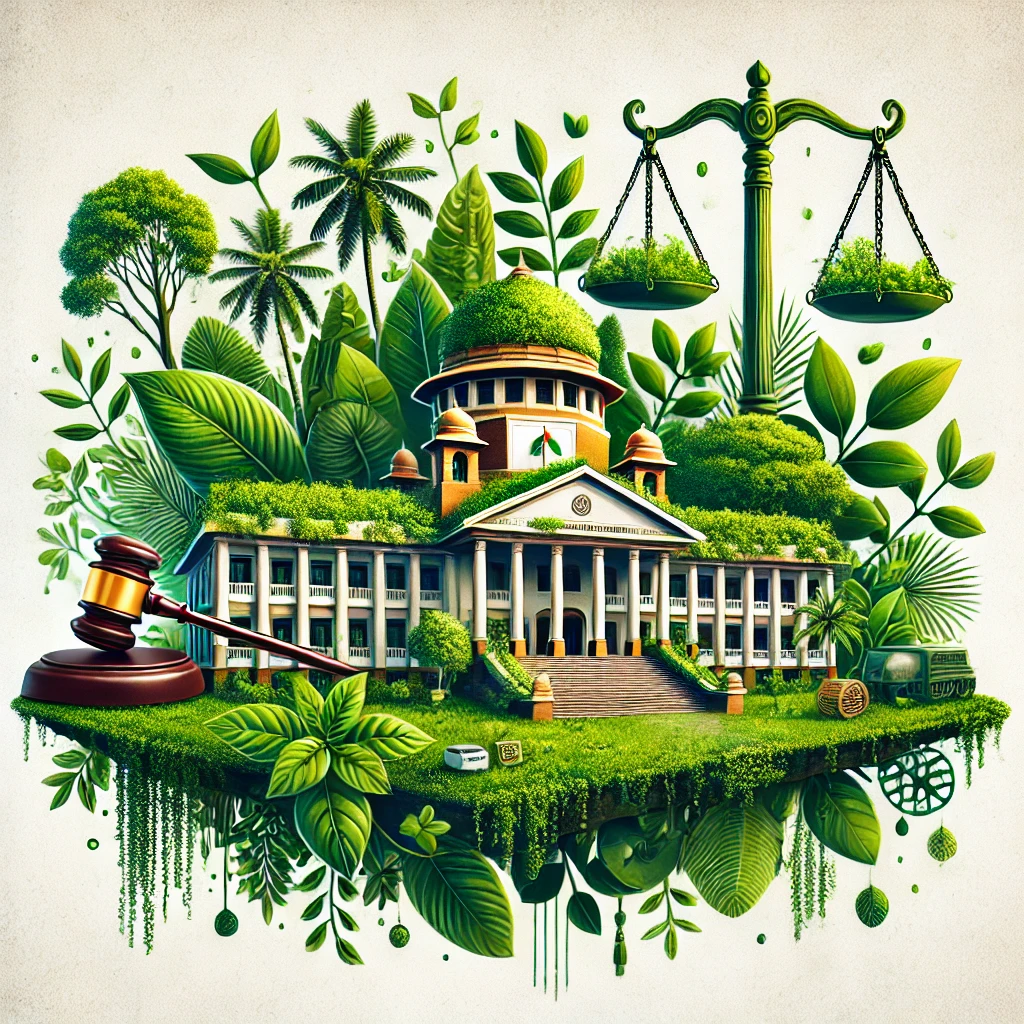Environmental laws at Sri Lanka
Sri Lanka, an island nation in South Asia, is rich in biodiversity and natural resources. However, the country faces significant environmental challenges, including deforestation, air and water pollution, overfishing, and the impacts of climate change. In response to these challenges, Sri Lanka has developed an extensive legal framework for environmental protection, aiming to promote sustainable development, conserve biodiversity, and protect natural resources.
Overview of Environmental Laws in Sri Lanka:
1. The National Environmental Act (NEA) No. 47 of 1980
The National Environmental Act (NEA) is the cornerstone of environmental law in Sri Lanka. It established the Central Environmental Authority (CEA), which is the primary government body responsible for environmental protection in the country.
The Act lays down provisions for the protection and improvement of the environment, including the regulation of pollution, waste management, and sustainable development practices.
Under the NEA, the CEA is responsible for regulating and monitoring environmental matters, such as air and water quality, hazardous waste management, and industrial pollution.
Environmental Impact Assessments (EIA) are required for certain types of development projects that are likely to have significant impacts on the environment, such as industrial facilities, large infrastructure projects, and mining operations. The Act mandates that an EIA be submitted to the CEA for approval before such projects proceed.
2. The Forest Ordinance (1907) and the Forest Conservation Ordinance (1956)
Sri Lanka has several laws focused on the conservation and management of its forest resources. The Forest Ordinance (1907) and the Forest Conservation Ordinance (1956) regulate the management and use of forest lands, including the creation of protected forests and the sustainable extraction of timber.
The Forest Conservation Ordinance prohibits the clearing of forests without prior government approval and provides for the designation of forest reserves and national parks. The government has also introduced measures to combat illegal logging and reduce deforestation, which has been a significant issue in Sri Lanka in recent decades.
In addition, the Forest Department manages the country's forest resources and works on reforestation and afforestation programs to restore degraded lands.
3. The Fauna and Flora Protection Ordinance (1937)
The Fauna and Flora Protection Ordinance (1937) provides the legal framework for the protection of Sri Lanka’s wildlife and natural habitats. It aims to conserve the country’s rich biodiversity by regulating hunting, poaching, and the trade of endangered species.
The Ordinance enables the government to establish national parks, wildlife sanctuaries, and nature reserves to protect critical ecosystems and wildlife habitats.
It is also the primary legal instrument for protecting endangered species in Sri Lanka, including the Sri Lankan elephant and leopard, as well as various species of flora and fauna.
Under this law, anyone involved in illegal hunting or trading of wildlife can face severe penalties, including fines and imprisonment.
4. The National Wetlands Policy (2005)
The National Wetlands Policy (2005) addresses the management and protection of wetlands in Sri Lanka, which are vital for biodiversity, water filtration, and flood control.
Sri Lanka is home to numerous wetlands that provide critical ecosystem services, such as regulating water cycles, supporting fisheries, and maintaining water quality. The National Wetlands Policy provides guidelines for the sustainable use and protection of these areas and promotes the restoration of degraded wetlands.
5. The Coast Conservation Act (1981)
The Coast Conservation Act (1981) is aimed at managing and conserving Sri Lanka's coastal resources. The law seeks to protect the coastal environment from erosion, pollution, and overdevelopment while promoting sustainable tourism and coastal development.
The Act established the Coast Conservation Department (CCD), which is responsible for implementing the provisions of the Act, including the coastal zone management plan, and regulating construction activities along the coastline.
The Act also provides for the creation of coastal protected areas and the regulation of activities that may harm coastal ecosystems, such as sand mining and unregulated construction.
6. The Prevention of Pollution (Control) Act (1990)
The Prevention of Pollution (Control) Act (1990) aims to regulate industrial pollution, particularly in relation to air, water, and noise pollution. This law is enforced by the Central Environmental Authority (CEA).
The Act requires industries to obtain pollution control permits before operating and sets limits on emissions and discharges into the environment. It also mandates the treatment of industrial effluents to prevent water pollution and the introduction of hazardous substances into the environment.
The Act also regulates the handling, transportation, and disposal of hazardous materials to prevent accidents and contamination of the environment.
7. The Fisheries and Aquatic Resources Act (1996)
The Fisheries and Aquatic Resources Act (1996) is aimed at regulating the fishing industry and ensuring the sustainable use of Sri Lanka's marine and freshwater resources. The law covers commercial and subsistence fishing, as well as the conservation of marine biodiversity.
The Act provides the legal framework for the management of fisheries resources, including the licensing of fishing vessels, the establishment of fishing quotas, and the regulation of fishing gear and methods.
It also includes provisions for the protection of marine ecosystems, such as marine protected areas (MPAs), and promotes sustainable practices to prevent overfishing, coral reef destruction, and the depletion of fish stocks.
8. The Land Development (Special Provisions) Act (2003)
The Land Development (Special Provisions) Act (2003) regulates land use in Sri Lanka, particularly in relation to large-scale land development and the protection of agricultural land. The law is designed to control land reclamation, the clearing of forests for agriculture, and the degradation of natural resources due to improper land use.
It provides guidelines for land management, land tenure, and conservation, and mandates the sustainable development of land resources.
9. The Urban Development Authority Act (1978)
The Urban Development Authority Act (1978) governs urban planning and development in Sri Lanka. The Act aims to promote sustainable urban growth while conserving natural resources and minimizing environmental impacts.
The Urban Development Authority (UDA) is responsible for planning and regulating urban development, including infrastructure projects, land use, zoning, and the creation of green spaces in urban areas.
The Act ensures that new developments are compatible with environmental standards and that urban growth does not come at the expense of the environment.
10. Climate Change Policies and Framework
Sri Lanka has developed several climate change policies to address the impacts of climate change and enhance resilience to climate-related risks. The National Climate Change Policy (2012) and the National Adaptation Plan for Climate Change focus on building resilience in vulnerable sectors such as agriculture, water resources, and coastal areas.
Sri Lanka is also a party to the Paris Agreement on climate change, committing to reduce greenhouse gas emissions and implement adaptation strategies to mitigate the effects of climate change.
The country is working to transition to renewable energy sources, improve energy efficiency, and implement disaster risk reduction measures as part of its climate change response strategy.
11. The Chemical Weapons Convention (CWC) and Hazardous Chemicals Regulations
Sri Lanka is a signatory to the Chemical Weapons Convention (CWC), which prohibits the use of chemical weapons and promotes the safe handling and disposal of hazardous chemicals.
The Hazardous Chemicals Control Act (2008) regulates the import, export, and use of hazardous chemicals in Sri Lanka to protect public health and the environment from the risks associated with chemical exposure.
Challenges and Opportunities:
Deforestation and Land Degradation: Despite regulations, deforestation and land degradation remain serious challenges in Sri Lanka. There is a need for stronger enforcement of forestry laws and greater efforts in reforestation and sustainable land use.
Waste Management: Solid waste management and pollution control, particularly in urban areas, are ongoing challenges. Improved infrastructure for waste disposal, recycling, and public education are needed.
Climate Change Vulnerability: Sri Lanka is highly vulnerable to the impacts of climate change, including rising sea levels, floods, and droughts. The country needs continued focus on climate change adaptation and building resilience in affected sectors.
Marine Conservation: Overfishing, coral reef degradation, and pollution continue to threaten Sri Lanka's marine biodiversity. Effective enforcement of fishing regulations and the expansion of marine protected areas are crucial for preserving marine ecosystems.
Conclusion:
Sri Lanka has a comprehensive legal framework for environmental protection, with key laws such as the National Environmental Act, the Forest Ordinance, and the Fauna and Flora Protection Ordinance addressing a wide range of environmental issues. The country is also focusing on sustainable development and climate change mitigation and adaptation. However, challenges like deforestation, waste management, and climate change impacts remain. Continued investment in enforcement, public awareness, and sustainable practices will be essential for Sri Lanka's environmental future.




























0 comments